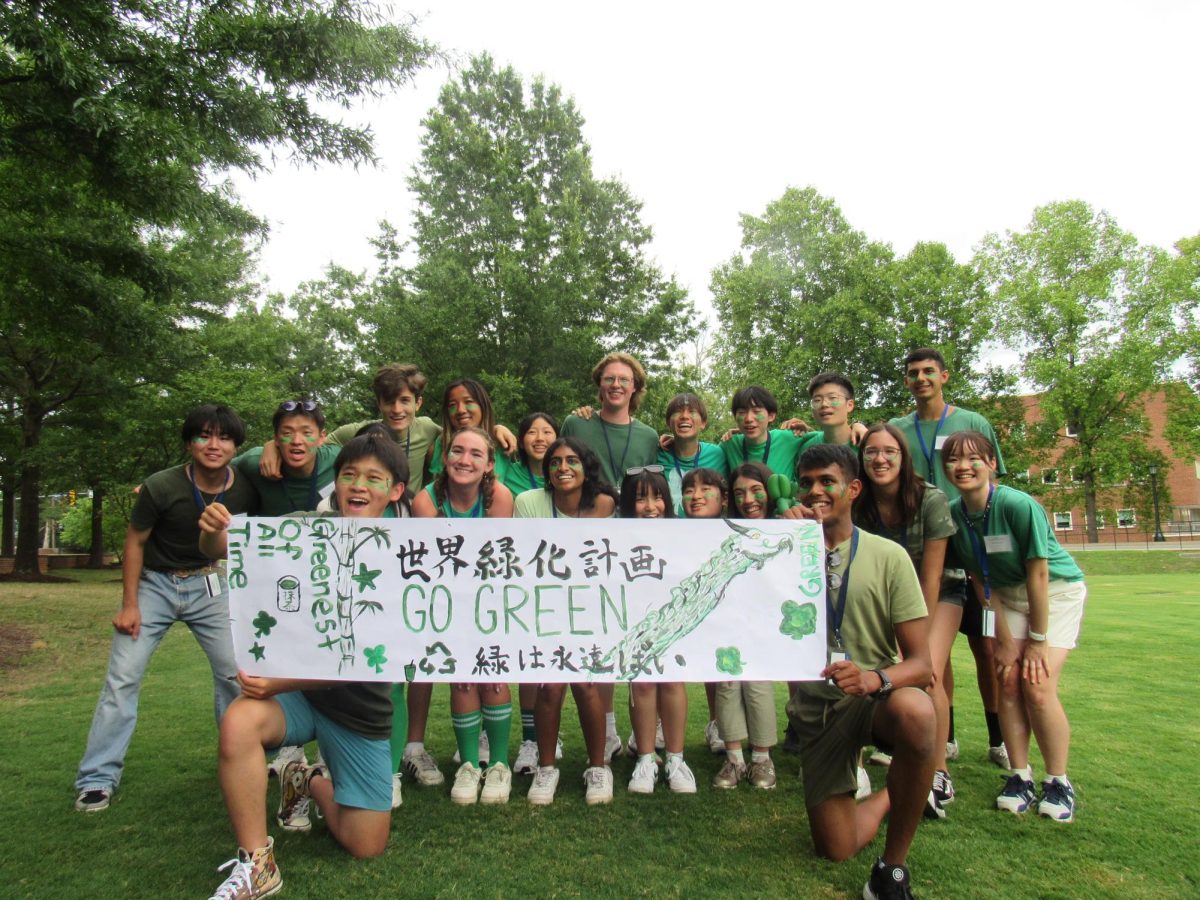Senior McKenna Lyons shares details on hosting Japanese students through the High School Diplomats program and learning about Japanese culture with students from across the United States and Japan.
High School Diplomats (HSD) is a scholarship program for Japanese and American high school students looking to share their culture and gain a better understanding of the everyday lives of high schoolers from across the globe. In 1987, AIU Insurance Company of Tokyo, now AIG Japan, created the HSD US program so Japanese students could visit America and experience American culture firsthand.
Seven years later, in 1987, the AIG and Freeman Foundation created the HSD Japan program for American students who previously attended HSD US. The goals of the program are to spread international understanding and foster meaningful connections from across borders.
The US branch of the program is hosted at The University of Virginia and senior Mckenna Lyons had the opportunity to attend the eight day program this summer. The program hosts 20 American students from all over the US. “Most were from the NOVA area, but there were people from California, Florida, New Jersey, and Texas. The Japanese students were also from all over Japan. Some were from Tokyo, Nogizaka, and some were from the countryside,” said Lyons.
Lyons hadn’t heard of the program until Mary Ann Ottenberg, the PFHS Career Center Counselor, had sent out an email detailing the program. After consulting with her family, Lyons decided it was a once in a lifetime opportunity.
She applied despite her low expectations of getting accepted. “We didn’t think I was gonna get in and figured, why not? It seemed like fun,” said Lyons.
Lyons had to fill out an application, write essays, and submit letters of recommendation. After completing the application, Lyons moved on to another round and was interviewed virtually. Although the process was long and extensive, it would lead to her acceptance into the program.
When asked what sparked her interest in the program, Lyons answer could be summed up in one word, “curiosity.” Lyons is not Japanese and before attending HSD US, knew very little about what life is like for Japanese high schoolers her age. “I didn’t know much about Japanese culture but wanted to broaden my worldview and perspective,” said Lyons.
After completing the program Lyons had a better understanding of not only the language and culture but also the experiences of Japanese teenagers her age.
The program encompassed several different activies ranging from Japanese classes, cultural classes, group presentations, meeting diplomats, and spirit activities. Each day of the program would start with group stretching followed by classes. “We would wake up and do Japanese stretching called Rajio Taiso. I loved it. It was a great way to wake up,” said Lyons.
Classes focused on speaking and writing in Japanese for the American students. “The American students would do Japanese lessons and learn how to write Japanese phrases like ‘good morning,’ ‘hello’ and other basic phrases,” said Lyons. The Japanese students also attended classes focused on American slang because they had a basic grasp of English.
One lesson that stood out to Lyons was when the Japanese students learned about American dating. Her Japanese peers were incredibly enthusiastic and wanted to use the slang they’d learned immediately. “They learned what a love triangle was, what cheating was, it was so funny. They came out of the lesson going, ‘oh he’s a player!’ It was so funny,” said Lyons.
After the Japanese and American students finished their lessons, they met back up for lunch. “We’d have lunch, and we went to the dining hall almost everyday,” said Lyons. When lunch was over they would participate in group discussions, meet diplomats, or plan spirit activities. Spirit activities took place during the afternoon and nighttime.
These activities served to familiarize the students with each other’s cultures. “We had a whole fourth of July USA day and also had a Japanese celebration called bunka no hi and we wore cultural clothes for that. There was a lot of sharing in between the cultures,” said Lyons.
Another important aspect of the program were the presentations students shared with their peers. The students were split into groups and gave presentations based on their country. Lyons presented on American pop culture and her peers gave presentations on education, social issues, and geographical regions. These presentations gave insight into how different life is for American and Japanese teenagers.
One major difference is high school itself. “Their high school is only three years because their middle school is a year longer than ours is. Instead of having freshmen, sophomores, juniors, and seniors, they have years one, two, and three,” said Lyons. Although American colleges are competitive and seemingly get more difficult to get into each year, the process for Japanese students is even scarier.
Japanese students have a much different experience than American students. “[They] take one big exam on 10 subjects and see their score and grade their tests themselves. Depending on their score that determines what colleges they get into,” said Lyons.
There may be strong differences between American and Japanese students but the bonds created at HSD were even stronger. Lyons’ favorite part of the program were the individuals she met. “They’re some of the best people I’ve met in my entire life. To this day, I get together with a lot of them. We had a day in DC, we went to one of their houses, and I still talk with my Japanese roommate,” said Lyons.
Lyons feels beyond grateful for this opportunity for several reasons. The first being that the odds of meeting her peers at HSD were so slim. “With 20 students from each country, it’s such a slim chance of meeting these people but I did,” said Lyons.
Another reason being that this experience showed her how students from across the ocean live. “While I may be the same age as my Japanese roommate, we had such different life experiences. Her everyday is so incredibly different but we live on the same planet. It really opened my world view,” said Lyons.
Spending so much time on the University of Virginia’s campus already enforced Lyon’s desire to attend as a student next year. The university is not only beautiful but also a powerhouse according to Lyons. “It’s one of the best public schools in the nation, and it’s in state for us. While it is a very difficult school to get into, I’d love to go there. Especially now that I know the campus really well, and I’ve stayed in the dorms,” said Lyons.
Lyons had the opportunity to welcome Japanese students to America and present her culture to foreigners through the HSD US program. The second part of the program, the HSD Japanese program, allows American students to visit Japan. Attendees must have already attended the sister program to apply.
Students must market the program, which is open to sophomores and juniors, in some way in order to spread the word.
“I’m really hoping to go to Japan because it’s a scholarship based program and would be an all paid trip. I had such a great experience, and I can’t imagine what the Japanese program would be like,” said Lyons.


